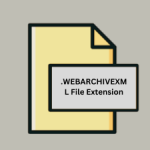.PHTML File Extension
What is an PHTML file?
Files with the .phtml extension are PHP web pages, where “PHP” stands for “Hypertext Preprocessor.” This file extension indicates that the file contains PHP code embedded within HTML. PHP is a server-side scripting language designed for web development but also used as a general-purpose language.
More Information.
PHP was created by Rasmus Lerdorf in 1993 and officially released in 1995. The .phtml extension was initially used to identify files processed by PHP, helping developers and servers distinguish them from static HTML files. Over time, .php became the preferred extension due to its simplicity and wider adoption, but .phtml continues to be used in some legacy systems.
Origin Of This File.
The .phtml file extension originates from PHP’s early days as a web technology. It was introduced as a way to distinguish PHP files from plain HTML files. Though .php is now the more common extension, .phtml is still in use.
File Structure Technical Specification.
A .phtml file is essentially an HTML file with embedded PHP code. When a web server processes the file, it interprets the PHP code and generates HTML output, which is then sent to the client’s browser. The PHP code is enclosed in <?php ... ?> tags, while regular HTML content is written as usual.
How to Convert the File?
Windows
- Using File Explorer:
- Navigate to the File: Open File Explorer and find the
.phtmlfile. - Rename the File: Right-click on the file and select “Rename.”
- Change the Extension: Replace
.phtmlwith.phpand press Enter. Confirm the change if prompted.
- Navigate to the File: Open File Explorer and find the
- Using Command Prompt:
- Open Command Prompt: Press
Win + R, typecmd, and press Enter. - Navigate to the Directory: Use the
cdcommand to navigate to the directory containing the file. - Rename the File: Use the command
ren filename.phtml filename.phpto rename the file.
- Open Command Prompt: Press
Linux
- Using File Manager:
- Navigate to the File: Open your file manager (e.g., Nautilus, Dolphin).
- Rename the File: Right-click the file and select “Rename.”
- Change the Extension: Replace
.phtmlwith.phpand press Enter.
- Using Terminal:
- Open Terminal: Open a terminal window.
- Navigate to the Directory: Use
cdto navigate to the directory containing the file. - Rename the File: Use the command
mv filename.phtml filename.phpto rename the file.
Mac
- Using Finder:
- Navigate to the File: Open Finder and locate the
.phtmlfile. - Rename the File: Right-click (or Control-click) the file and select “Rename.”
- Change the Extension: Replace
.phtmlwith.phpand press Enter. Confirm the change if prompted.
- Navigate to the File: Open Finder and locate the
- Using Terminal:
- Open Terminal: Open the Terminal application.
- Navigate to the Directory: Use
cdto navigate to the directory with the file. - Rename the File: Use the command
mv filename.phtml filename.phpto rename the file.
Android
- Using File Manager Apps:
- Open File Manager: Use a file manager app like “Files by Google” or “Solid Explorer.”
- Navigate to the File: Locate the
.phtmlfile. - Rename the File: Long-press the file, select “Rename,” and change the extension to
.php. Confirm the change.
- Using File Editing Apps:
- Open File Editing App: Use an app like “AIDE” or “Quoda.”
- Edit the File Name: Open the
.phtmlfile and use the app’s renaming function to change the extension to.php.
iOS
- Using File Management Apps:
- Open File Management App: Use apps like “Files” or third-party file managers.
- Navigate to the File: Locate the
.phtmlfile. - Rename the File: Tap and hold the file, select “Rename,” and change the extension to
.php.
- Using Code Editors:
- Open Code Editor: Use editors like “Textastic” or “Koder.”
- Rename the File: Open the file and use the editor’s file management features to rename it to
.php.
Others
General Approach:
- Identify the File: Locate the
.phtmlfile using your system’s file management tool or command line. - Rename the File: Use the file renaming features of the operating system or application you are using. This generally involves changing the file extension from
.phtmlto.php.
Advantages And Disadvantages.
Advantages:
- Server-Side Processing: PHP allows for dynamic content generation based on server-side logic.
- Flexibility: PHP can interact with databases, manage sessions, and perform other server-side tasks.
- Compatibility:
.phtmlfiles are supported by any web server that can process PHP scripts.
Disadvantages:
- Performance Overhead: Server-side processing can be slower compared to serving static HTML files.
- Security Risks: Improper handling of PHP code can lead to security vulnerabilities like SQL injection or cross-site scripting (XSS).
- Legacy Usage: The
.phtmlextension is less common than.php, which might cause confusion in mixed environments.
How to Open PHTML?
Open In Windows
- Web Browsers: Internet Explorer, Chrome, Firefox, Edge (when served by a PHP-enabled server).
- Text Editors: Notepad++, Visual Studio Code, Sublime Text, etc.
Open In Linux
- Web Browsers: Firefox, Chrome, Chromium.
- Text Editors: Gedit, Nano, Vim, Visual Studio Code, etc.
- Server: Apache, Nginx (configured to process PHP).
Open In MAC
- Web Browsers: Safari, Chrome, Firefox.
- Text Editors: TextEdit, Sublime Text, Visual Studio Code, etc.
- Server: Apache, Nginx (with PHP installed).
Open In Android
- Web Browsers: Chrome, Firefox.
- Text Editors: Quoda, AIDE, etc. (Editing may be limited.)
Open In IOS
- Web Browsers: Safari, Chrome.
- Text Editors: Textastic, Koder, etc. (Editing may be limited.)
Open in Others
Web Servers: Any server capable of processing PHP can handle .phtml files, such as Apache, Nginx, or IIS.














